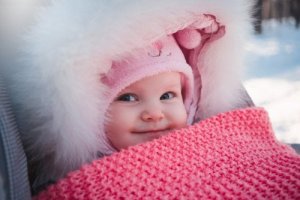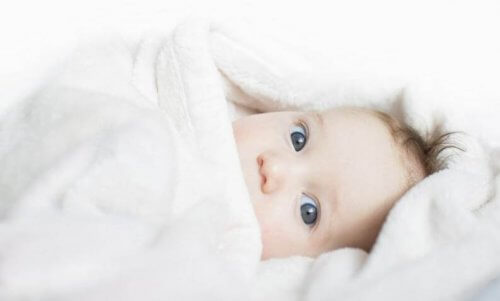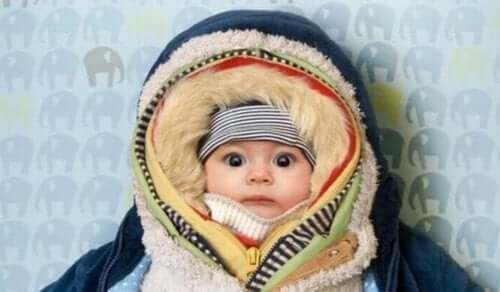Winter Clothing for Newborn Babies

Dressing a baby properly can be a challenge, especially in extreme weather. Babies are more sensitive to temperature, but since they can’t tell you if they’re hot or cold, choosing winter clothing for newborns can be a challenge.
In the winter, babies need to be more bundled up than normal to avoid sudden changes in their body temperature. Babies regulate their body temperature through their heads, so make sure to cover them up with a hat or a hood. Their hands and feet are more exposed than other parts of the body, so pay special attention there as well.
That being said, it’s important not to overheat your baby. Too much clothing can increase your baby’s body temperature and bring undesired consequences. If your baby is hot and sweating a lot, for example, they could develop a rash or skin irritation.
What kind of winter clothing does a newborn need?
Putting together your baby’s wardrobe doesn’t have to be overly complicated. The important thing is making sure you have the basics necessary for your baby’s safety and comfort. You don’t need expensive brand-name clothes or any high-tech materials. Practicality and comfort should be your highest priority.
First of all, you’ll need undershirts, preferably cotton because they don’t cause allergies and allow the skin to breathe. The same goes for pants.
Next, there are lots of options to protect the baby’s extremities. The most important are hats, socks, and mittens. If you’re at home with your baby, you don’t need to worry about mits or mittens. Experts believe that newborns should have their hands free in order to have contact with their surroundings.

Tips for dressing your newborn in winter
Layers are best
Dressing your baby in layers is the easiest way to make sure they’re warm enough. You can start with the undershirt, and then sweatpants or fleece pants. Make sure your newborn always wears socks and a hat in the winter.
On top of that layer, it’s good to add a sweater or a jacket with a hood if you’re going to go outside. The great thing about layers is that you don’t have to worry about changing the baby completely as you go back and forth between outside and inside.
One layer more than mommy and daddy
Babies are just a little bit more sensitive to cold than adults. A useful trick to remembering how much winter clothing they need is to dress them in one layer more than you’re wearing. Depending on the outfit, this extra layer could just be an undershirt.
The best way to check a baby’s body temperature is to feel their neck or belly. Experts don’t recommend using their hands and feet as a reference because they’re usually cold.

Essential winter clothing accessories for a walk
While healthcare professionals don’t recommend taking the baby out of the house until a month after they’re born, there are still some important factors to consider. The most important is planning your outing and knowing your destination. That way you can be prepared with the right kind of clothes.
- Coat or jacket. If you’re going somewhere on foot, dress the baby in a coat or jacket. Hooded jackets are the most common because they protect your baby’s head and neck from the cold and wind. Lined hoods are extra comfortable and warm for your baby.
- Wool or fleece blankets. Blankets are always useful, even in the summer. In the winter, they’re great for keeping the baby warm without having to worry about a jacket.
- Bunting bags. These are great for keeping babies warm in their strollers and car seats. Their closure system prevents drafts so the baby stays nice and warm.
The “one more layer” rule is helpful for deciding what winter clothing your newborn needs.
Another useful item is a stroller weather shield. This transparent cover protects your baby from wind and drafts when you’re out and about. There are also strollers that let you adjust the direction of the handlebar so you don’t expose your baby directly to the wind.
Dressing a baby properly can be a challenge, especially in extreme weather. Babies are more sensitive to temperature, but since they can’t tell you if they’re hot or cold, choosing winter clothing for newborns can be a challenge.
In the winter, babies need to be more bundled up than normal to avoid sudden changes in their body temperature. Babies regulate their body temperature through their heads, so make sure to cover them up with a hat or a hood. Their hands and feet are more exposed than other parts of the body, so pay special attention there as well.
That being said, it’s important not to overheat your baby. Too much clothing can increase your baby’s body temperature and bring undesired consequences. If your baby is hot and sweating a lot, for example, they could develop a rash or skin irritation.
What kind of winter clothing does a newborn need?
Putting together your baby’s wardrobe doesn’t have to be overly complicated. The important thing is making sure you have the basics necessary for your baby’s safety and comfort. You don’t need expensive brand-name clothes or any high-tech materials. Practicality and comfort should be your highest priority.
First of all, you’ll need undershirts, preferably cotton because they don’t cause allergies and allow the skin to breathe. The same goes for pants.
Next, there are lots of options to protect the baby’s extremities. The most important are hats, socks, and mittens. If you’re at home with your baby, you don’t need to worry about mits or mittens. Experts believe that newborns should have their hands free in order to have contact with their surroundings.

Tips for dressing your newborn in winter
Layers are best
Dressing your baby in layers is the easiest way to make sure they’re warm enough. You can start with the undershirt, and then sweatpants or fleece pants. Make sure your newborn always wears socks and a hat in the winter.
On top of that layer, it’s good to add a sweater or a jacket with a hood if you’re going to go outside. The great thing about layers is that you don’t have to worry about changing the baby completely as you go back and forth between outside and inside.
One layer more than mommy and daddy
Babies are just a little bit more sensitive to cold than adults. A useful trick to remembering how much winter clothing they need is to dress them in one layer more than you’re wearing. Depending on the outfit, this extra layer could just be an undershirt.
The best way to check a baby’s body temperature is to feel their neck or belly. Experts don’t recommend using their hands and feet as a reference because they’re usually cold.

Essential winter clothing accessories for a walk
While healthcare professionals don’t recommend taking the baby out of the house until a month after they’re born, there are still some important factors to consider. The most important is planning your outing and knowing your destination. That way you can be prepared with the right kind of clothes.
- Coat or jacket. If you’re going somewhere on foot, dress the baby in a coat or jacket. Hooded jackets are the most common because they protect your baby’s head and neck from the cold and wind. Lined hoods are extra comfortable and warm for your baby.
- Wool or fleece blankets. Blankets are always useful, even in the summer. In the winter, they’re great for keeping the baby warm without having to worry about a jacket.
- Bunting bags. These are great for keeping babies warm in their strollers and car seats. Their closure system prevents drafts so the baby stays nice and warm.
The “one more layer” rule is helpful for deciding what winter clothing your newborn needs.
Another useful item is a stroller weather shield. This transparent cover protects your baby from wind and drafts when you’re out and about. There are also strollers that let you adjust the direction of the handlebar so you don’t expose your baby directly to the wind.
This text is provided for informational purposes only and does not replace consultation with a professional. If in doubt, consult your specialist.








